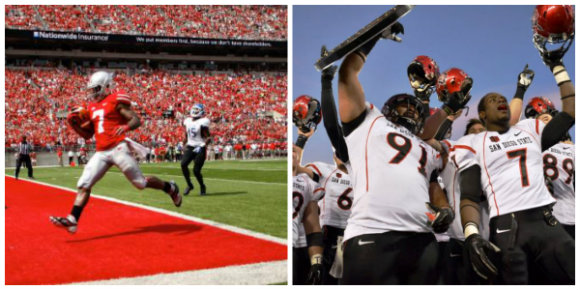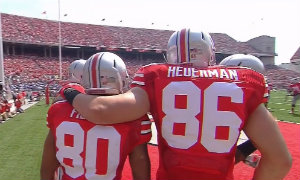
Because of you fine folks who volunteered for the charting project, I (and any of you) get more data to play with each week this season. It'll allow us to examine and reexamine some of the common memes from the previous game – "Was Decker beaten on almost every play? Did the Buckeye offense fall asleep after the first quarter? Do the Buckeyes have anyone to throw to?" – with some empirical evidence.
While I don't have charting data for our opponents (yet), I'll also provide some statistical context for the game you'll be watching in the next two days. This week it's San Diego State University, who many thought would be a tricky opponent – that is, until they lost 40-19 to FCS Eastern Illinois. Whoops.
Charting Buffalo
One thing Zach Smith has harped on this offseason was increasing yards after catch (YAC):
"Philly was the first to say that for however many catches he had, the fact that he didn't have 1,000 yards receiving, he even said that's a joke. I mean, what are we talking about? He's much better than that."
Buckeye receivers could stretch the field (Devin Smith), have high catch rates (Philly Brown), and block well (Evan Spencer), but few had the wiggle room to turn short catches in to big gains. The problem here is that Braxton's completion percentage was far higher for short passes.
| Receiver | Air Yards | Yards |
|---|---|---|
| D. Smith | 47 | 47 |
| Wilson | 0 | 18 |
| Fields | 25 | 25 |
| Spencer | 5 | 10 |
| Fields | 7 | 7 |
| Brown | 8 | 8 |
| Smith | 3 | 9 |
| Brown | 10 | 17 |
| HEUERMAN | 3 | 3 |
| HEUERMAN | 2 | 9 |
| SPENCER | 5 | 5 |
| SMITH | 2 | 5 |
| HALL | -5 | 1 |
| FIELDS | 21 | 21 |
Enter our new crop of freshmen playmakers. Only Dontre had an opportunity to show his skills against Buffalo, but he was one of the few receivers with a high yards-after-catch as well.
The table to the left shows what receivers did after making a catch. "Air yards" is the distance in yards that the ball was in the air, while "yards" is the total gain on the play. Subtract "air yards" from "yards" and, voilà – yards after catch.
This is only through three quarters of play, but it demonstrates that Dontre was almost the only receiver to gain any YAC against Buffalo.
Sure, Philly, Hall, and Heuerman had a few decent runs after catching the ball, but the Buckeye offense will certainly be looking for more than just one swing pass per game go for a high YAC.
The data also shows that Braxton is still probably most comfortable throwing shorter passes, as almost all quarterbacks are. Braxton only attempted two throws for more than ten yards through three quarters last week (albeit with improved mechanics!).
I then took a look at third down playcalling. Braxton did the majority of his drop back passing (without play action or packaged run/pass option) on third downs. Of the Buckeyes' twelve third downs (58% success rate), there were only three designed runs (two inside zone reads and one Dave) and two scrambles from Braxton – the other nine were short to intermediate passes.
Further, two of Braxton's three sacks came on third down, which is what we might expect given the higher number of drop-back passes.
Some quick hitters from the charting data:
- Blitzes were fairly effective against the Buffalo offense. Rushing six on defense severely rattled Licata, leading to multiple errant throws (looking at you, Joey Bosa). Only the backup QB, Zordich, had any kind of running success against the 6-man rush.
- The linebackers and Reeves received the most "minuses" on defense – primarily from reacting slowly or overrunning plays/getting out of position to make a tackle.
- Decker had more plusses than minuses, but all minuses were for pass blocking against Mack.
- In general, the offensive line responded well to five rushers but couldn't handle blitzes of six or more defenders. We will have to watch in future weeks whether defensive coordinators sell out on blitzes (especially on third downs) because they don't fear Miller's passing game.
- Miller's throwing mechanics were much improved, especially in the first half. This showed by his pass accuracy, which included thirteen "dead on," three "catchable," and only three "bad" passes.
- Packaged plays are somewhat difficult to identify, but the charting volunteers found three definite packaged plays – one of which Braxton saved by pulling down and scrambling.
The charting project data will only get better with more practice and more contributors, so go volunteer to chart the SDSU game.
 Great catch rates, but both could improve their YA
Great catch rates, but both could improve their YALooking Ahead to SDSU
There's no way around the fact that SDSU lost by 21 points to Eastern Illinois last weekend, but I will say that the team wasn't terrible statistically despite the loss.
It's only one game of data, but SDSU is just 61st overall in F/+ standings, which is actually in front of teams like Auburn, Cal, and Minnesota.
The problem for SDSU was turnovers – all five of them – and three and outs. A third of the Aztec's eighteen drives failed to gain ten yards and that doesn't include several other drives that gained more than ten yards, but still resulted in a turnover.
Their offense ran an astounding 99 plays, but at only a 4.44 yards per play average.
| Yards per Play | Points per Play | Yards per Point |
|---|---|---|
| 4.44 | .19 | 23.16 |
These are not good numbers for the SDSU offense, but they're actually slightly better than Buffalo's last week.
Based on the data, it's unfair to say that SDSU is terrible, just as Buffalo wasn't terrible. What's key is that the Buckeyes keep the peddle to the floor and cut down on mistakes so that this game becomes a blowout even if SDSU's quarterback Dingwell doesn't throw four interceptions.

